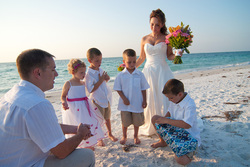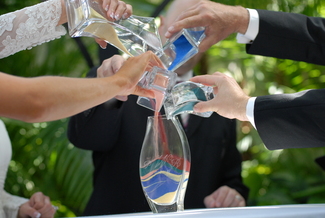
When one or both partners have children the question arises:
"Should we include our kids in the ceremony?"
Usually parents want to do this and want to do it in the most successful way possible. I'm not referring here to adult children, of course, but children who have not yet left home.
If your children will be living with you, or if they will be sharing their time between you and their other parent, it can be a great comfort to them to be included. Blending the family in a ceremony reassures them of their place, and shows them welcome and acceptance in a way that words alone cannot.
Giving the children jobs within the ceremony can work well, depending on their ages. Being the flower girl or ring bearer gives your child a sense of his or her importance to the family as well as to the event.
Additionally, I suggest Family Vows in which both members of the couple promise to include, protect and welcome the child, or children, into this new family. After the parents have given their pledge to the children, I ask the children a simple question: "Will you support this new family of yours as best you can?" I tell the parents during our planning meeting, that as long as they know their children will respond with some version of "yes," this is a good thing to include!
After the Family Vows, all the members of this new nuclear family can participate in pouring sand into the Unity Sand vessel. Each person's sand should be a different color, and one that will blend with the other colors to be used. The different colors of sand intermingle as each person takes multiple turns with the others adding layers of color.
Parents will often give each child a small gift that is a surprise to the child, presenting it either after the Family Vows, or after the Unity Sand has been poured.
This part of the ceremony may seem as if it is primarily for the children, but that isn't accurate.
The ritual of making promises, giving gifts, speaking vows and pouring sand have a bonding and transforming effect on everyone involved–even your guests. It can be healing for those who've had difficult experiences with blending families successfully in their past.

 RSS Feed
RSS Feed
